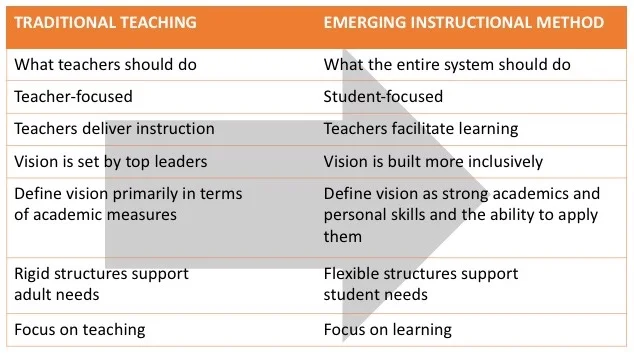Transforming K-12 Facilities For 21st Century Learning
As we enrich our educational system with 21st Century knowledge, we begin to understand teaching and learning from a modern perspective. We love this chart from the International Center for Leadership in Education. It highlights the shift from teaching to learning.
With continued testing and trial of new learning modalities, the need to support core instructional changes through our existing infrastructure becomes apparent. In this blog, we share our research, knowledge and experiences in understanding a deeper approach to transforming K-12 facilities for the future. We encourage you to share your thoughts and comments.
Sustainability
School buildings can enhance a student’s ability to learn by keeping them healthy, attentive and present. Learning environments have a direct impact on educational performance. Sustainably designed schools provide our occupants with clean and healthy air to breathe, improved acoustics, continuous access to daylight and thermal comfort. Striving for LEED-certification is a big goal - focusing consistently on simple upgrades such as lighting and window replacements gets your district closer to net-zero.
Holistic Visioning (aka Thinking Beyond The C.I.P.)
As aging buildings become in need of repair, traditional capital planning projects present the opportunity to address the initiative for relief on natural resources and provide program improvements which address change in 21st Century learning methodology. When facing an upcoming capital improvement project, thinking beyond the typical allows the project to be explored to limitless opportunities, including:
- PROGRAM CHANGES. Consider multi-purpose at the large scale AND at the individual room scale. Spaces that are adaptable and flexible can eliminate the need for future renovations.
- ROOFING Think about increasing insulation, air sealing wall tops, replacing with light-reflective material and adding rooftop gardens for outdoor learning.
- HVAC SYSTEMS The controllability of the interior environment is directly linked to the building envelope and operating conditions. Improving energy efficiency is greater than just replacing outdated equipment.
Technology
As technology evolves into a component of everyday education it affects the building systems that support our learning devices. With greater demand on IT infrastructure, keeping networks strong and secure is imperative in ensuring instruction will be delivered. Integrating technology during design is important; don’t forget to add more power outlets in the classroom.
Security
When viewed as a design solution, security consists of advanced technology systems, strategic space planning and close attention to high-performing material and finish selections.
- VISUAL DETECTION. Know who is visiting before they enter, and validate their visit prior to granting access. Entry systems with cameras and microphones allow communication between closed doors.
- ENTRY LOCKDOWN Secure and monitor ALL building entrances at ALL times, and integrate technology in lockdown efforts.
- OPEN SIGHT LINES. Clear sight lines throughout the interior and to the outdoors keeps eyes on safety real-time. For example, adding interior windows between offices and corridors lets staff know who is on the other side of the wall.
- EXTRA PROTECTION. Enhanced security with a control desk provides an immediate sense of a secure facility upon arrival. With a friendly greeting and direction, a visitor can now be monitored throughout the building.
Traffic Safety
Parents and guardians can be in a rush, but we must never sacrifice safety. It is crucial to ensure traffic is safe during morning drop-off and afternoon pick-up. A proper site reconfiguration improves traffic control for routine school days and special events. Features including one-way traffic loops and parking lot islands calm vehicle speed and give pedestrians a safe right-of-way.




